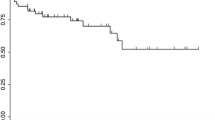Abstract
Visual field deficits can be a consequence of brain tumor location or treatment. The prevalence of unrecognized visual field deficits in children diagnosed with brain tumors is not known. All children at a single tertiary care pediatric children’s hospital diagnosed with a primary brain tumor were tested for visual field deficits by a child neurologist and neuro-ophthalmologist over 16 months. Children with reproducible visual field deficits on two separate occasions were included in the analysis. Patients with optic glioma, craniopharyngioma, or previously known visual field deficits were excluded. Fourteen of 92 (15.2%) children (average 8.9 years, 8 girls) had undiagnosed visual field deficits. Average time between diagnosis of tumor and unrecognized visual field deficit was 3.7 years (range 0–13 years). Unrecognized visual field deficits were not associated with age (P = 0.27) or gender (P = 0.38). Visual field deficits were attributed to direct tumor infiltration (n = 8), postoperative complications (n = 5) and post-radiation edema (n = 1). Deficits included bitemporal hemianopsia (n = 2), homonymous hemianopsia (n = 9), quadrantanopsia (n = 2), and concentric visual field loss (n = 1.) Tumor location included temporal lobe (n = 9), parietal lobe (n = 2), posterior fossa (n = 2), hypothalamic-chiasmatic (n = 2) and multifocal areas (n = 4). Children with temporal lobe tumors were more likely to have unrecognized visual field deficits (P = 0.004). In all 14 patients, visual field deficits were determined by examination only and were not reported by either the patient or caregiver regardless of age. The prevalence of unrecognized visual field deficits in children with brain tumors can be surprisingly high. Serial neuro-ophthalmologic evaluation of children with brain tumors is often required to diagnose a visual field deficit since patient or caregiver reporting may be limited.

Similar content being viewed by others
References
Porter KR, McCarthy BJ, Freels S, Kim Y, Davis FG (2010) Prevalence estimates for primary brain tumors in the United States by age, gender, behavior, and histology. Neuro Oncol 12:520–570
Wilne S, Collier J, Kennedy C et al (2007) Presentation of childhood CNS tumours: a systematic review and meta-analysis. Lancet Oncol 8:685–695
Snyder H, Robinson K, Shah D, Brennan R, Handrigan M (1993) Signs and symptoms of patients with brain tumors presenting to the emergency department. J Emerg Med 11:253–258
Wilne SH, Ferris RC, Nathwani A, Kennedy CK (2006) The presenting features of brain tumours: a review of 200 cases. Arch Dis Child 9:502–506
Armstrong GT, Conklin HM, Huang S et al (2011) Survival and long-term health and cognitive outcomes after low-grade glioma. Neuro Oncol 13:223–234
Santamaría A, Martínez R, Astigarraga I, Etxebarría J, Sánchez M (2008) Ophthalmological findings in pediatric brain neoplasms: 58 cases. Arch Soc Esp Oftalmol 83:471–477
Acknowledgments
Dr. Harbert, Lanipua Yeh-Nayre, Dr. O’Halloran, and Dr. Crawford have nothing to disclose. Dr. Levy serves on the editorial advisory boards of Neurosurgery, World Neurosurgery, and the Journal of Health Communication; serves on a scientific advisory board for and holds stock/stock options in Stemedica Cell Technologies, Inc.; and is listed as author on a patent re: absorbable biowax (now owned by USC), for which he receives royalty payments from Children’s Hospital Los Angeles.
Conflict of interest
The authors report no conflicts of interest.
Author information
Authors and Affiliations
Corresponding author
Rights and permissions
About this article
Cite this article
Harbert, M.J., Yeh-Nayre, L.A., O’Halloran, H.S. et al. Unrecognized visual field deficits in children with primary central nervous system brain tumors. J Neurooncol 107, 545–549 (2012). https://doi.org/10.1007/s11060-011-0774-3
Received:
Accepted:
Published:
Issue Date:
DOI: https://doi.org/10.1007/s11060-011-0774-3




